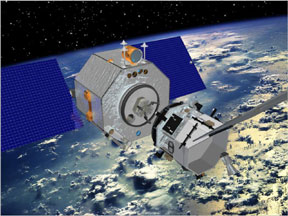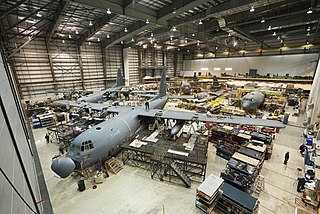
The Canadian Space Agency is the national space agency of Canada, established in 1990 by the Canadian Space Agency Act.

The Mobile Servicing System (MSS), is a robotic system on board the International Space Station (ISS). Launched to the ISS in 2001, it plays a key role in station assembly and maintenance; it moves equipment and supplies around the station, supports astronauts working in space, and services instruments and other payloads attached to the ISS and is used for external maintenance. Astronauts receive specialized training to enable them to perform these functions with the various systems of the MSS.

Robert Laurel Crippen is an American retired naval officer and aviator, test pilot, aerospace engineer, and retired astronaut. He traveled into space four times: as pilot of STS-1 in April 1981, the first Space Shuttle mission; and as commander of STS-7 in June 1983, STS-41-C in April 1984, and STS-41-G in October 1984. He was also a part of the Manned Orbiting Laboratory (MOL), Skylab Medical Experiment Altitude Test (SMEAT), ASTP support crew member, and the Approach and Landing Tests (ALT) for the Space Shuttle.

SSL, formerly Space Systems/Loral, LLC (SS/L), of Palo Alto, California, is a wholly owned manufacturing subsidiary of Maxar Technologies.

STS-100 was a Space Shuttle mission to the International Space Station (ISS) flown by Space Shuttle Endeavour. STS-100 launch on 19 April 2001, and installed the ISS Canadarm2 robotic arm.
Pacific Western Airlines Ltd (PWA) was an airline that operated scheduled flights throughout western Canada and charter services around the world from the 1950s through the 1980s.

Canadarm or Canadarm1 is a series of robotic arms that were used on the Space Shuttle orbiters to deploy, manoeuvre, and capture payloads. After the Space Shuttle Columbia disaster, the Canadarm was always paired with the Orbiter Boom Sensor System (OBSS), which was used to inspect the exterior of the shuttle for damage to the thermal protection system.

Dextre, also known as the Special Purpose Dexterous Manipulator (SPDM), is a two-armed robot, or telemanipulator, which is part of the Mobile Servicing System on the International Space Station (ISS), and does repairs that would otherwise require astronauts to do spacewalks. It was launched on March 11, 2008, on the mission STS-123.

Israel Aerospace Industries or IAI (תע"א) is Israel's major aerospace and aviation manufacturer, producing aerial and astronautic systems for both military and civilian usage. It has 15,000 employees as of 2018. IAI is state-owned by the government of Israel.

The Orbiter Boom Sensor System (OBSS) was a 50-foot boom carried on board NASA's Space Shuttles. The boom was grappled by the Canadarm and served as an extension of the arm, doubling its length to a combined total of 100 feet. At the far end of the boom was an instrumentation package of cameras and lasers used to scan the leading edges of the wings, the nose cap, and the crew compartment after each lift-off and before each landing. If flight engineers suspected potential damage to other areas, as evidenced in imagery captured during lift-off or the rendezvous pitch maneuver, then additional regions could be scanned.

Orbital Express was a space mission managed by the United States Defense Advanced Research Projects Agency (DARPA) and a team led by engineers at NASA's Marshall Space Flight Center (MSFC). The Orbital Express program was aimed at developing "a safe and cost-effective approach to autonomously service satellites in orbit". The system consisted of two spacecraft: the ASTRO servicing satellite, and a prototype modular next-generation serviceable satellite; NEXTSat. The mission launched from Cape Canaveral Air Force Station on 8 March 2007, aboard an Atlas V expendable launch vehicle. The launch was part of the United States Air Force Space Test Program STP-1 mission.
The following outline is provided as an overview of and topical guide to the aerospace field:

SED Systems is a communications company supplying both systems and services to the satellite industry. Originating in 1965, SED is located in the Innovation Place Research Park on the University of Saskatchewan campus. As an operating division of the Calian Group Ltd., SED employs approximately 280 employees and annually achieves sales of over 80 million dollars.
MDA Ltd. is a Canadian space technology company headquartered in Brampton, Ontario, Canada, that provides geointelligence, robotics and space operations, and satellite systems.

Grapple fixtures are used on spacecraft or other objects to provide a secure connection for a robotic arm.

Cascade Aerospace Inc. of Abbotsford, British Columbia, Canada is a specialty aerospace and defence contractor, focused on providing long-term integrated aircraft support programs for Original Equipment Manufacturers (OEMs), military, government and commercial customers.

Docking and berthing of spacecraft is the joining of two space vehicles. This connection can be temporary, or partially permanent such as for space station modules.
Space Infrastructure Servicing (SIS) is a spacecraft concept being developed by Canadian aerospace firm MDA to operate as a small-scale in-space refueling depot for communication satellites in geosynchronous orbit.
COM DEV International was a satellite technology, space sciences, and telecommunications company based in Cambridge, Ontario, Canada. The company had branches and offices in Ottawa, the United States, the United Kingdom, China and India.
Maxar Technologies Inc. is a space technology company headquartered in Westminster, Colorado, United States, specializing in manufacturing communication, Earth observation, radar, and on-orbit servicing satellites, satellite products, and related services. DigitalGlobe and MDA Holdings Company merged to become Maxar Technologies on October 5, 2017.













